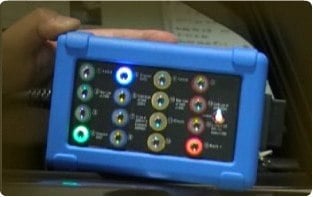
PicoScope 7 Automotive
Available for Windows, Mac, and Linux, the next evolution of our diagnostic scope software is now available.
The CAN Test Box uses numbered backlit LEDs which illuminate when signal data is present on the corresponding pin of the DLC. Pulsing LEDs indicate signals being pulled high/low.
The LEDs indicate the following signals:
The CAN Test Box allows you to connect your PicoScope oscilloscope or any other compatible scope, enabling you to monitor any signals present such as the CAN High and Low signals. The CAN Test Box terminal pin ports are compatible with standard 4 mm jacks.
The CAN Test Box includes a 2.5 metre (8.2 feet) cable so that you can work in a convenient location away from the diagnostic connector, and an additional pass-through connector so that you can hook up your scan tool at the same time as your scope. The box is powered by the diagnostic connector, so no batteries or mains adaptor are needed.

The connection of the Can Test Box to the 16 pin vehicle diagnostic connector provides a non-intrusive test point for all associated circuits, whilst LED’s will illuminate to indicate the status of the 16 pins. The 4mm banana sockets enable simple connection of PicoScope for circuit analysis, “jumper wires” for flash code interrogation, and on board “memory save” devices (During battery disconnection) With the pass-through connector and 2.5 meter cable, the Can Test Box can be used in series with your scan tool and remote from the 16 pin connector allowing for simultaneous scan tool and scope tests. (See below)
| Transcribe_404: 3374 [title] | Transcribe_404: 3370 [language] | Transcribe_404: 3373 [issue] | Transcribe_404: 3375 [size] | Transcribe_404: 3371 [updated] | Transcribe_404: 3137 [all products] | Transcribe_404: 3368 [all languages] | Transcribe_404: 3367 [all documents] | Transcribe_404: 3372 [status] |
|---|---|---|---|---|---|---|---|---|
| PP619 CAN Test Box User’s Guide | 5 | 1 MB | Apr 07 2022 | Breakout leads/boxes | ||||
| CAN Test Box Kurzübersicht Benutzerhandbuch | german | 2 | 558 KB | Apr 07 2022 | Breakout leads/boxes | german |
| Transcribe_404: 3310 [product] | Transcribe_404: 3314 [price] | Transcribe_404: 3369 [quantity] | |
|---|---|---|---|
Jerry smith
CAN Test Box





Works great for can diagnostics. Especially with K line that needs a scantool hooked up while testing data waveform
Robert Burgy
CAN Test Box





If you are serious about diagnostics. This product is a must!
Use it to check your Bus connection and data. You can’t go wrong with this
product. easy to use. Very well built product.